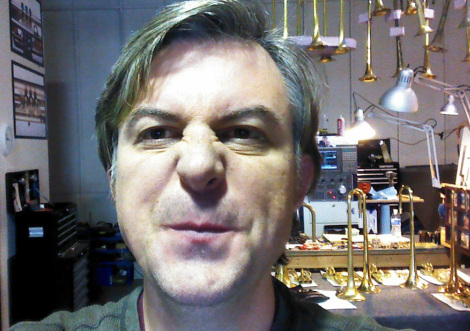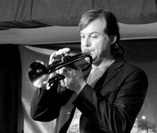 Being a self-taught engineer, machinist and metal fabricator, my perspective on manufacturing is somewhat unusual. I tend to see all things as two physical realities with the potential to become one. The first reality is the physical object whether it be man-made natural or the traditional definition of natural. I focus on seamless integration of both object and human allowing us to achieve something greater than was previously possible. As a boy, I dreamed of being an inventor hoping to someday solve the world's energy problems while building and flying my own airplanes around the globe. What can I say, I was a dreamer. In high school, I was considering enlisting in the Air Force with the ultimate goal of being a fighter pilot when my Billings, Montana band director, Gary Tangen, changed my life. In one hour he challenged me to become a great musician and got me hooked on playing trumpet for life. Over the next few years, I became more and more interested in the physics involved in playing trumpet to overcome my own embouchure deficiencies, which had left me with little range or endurance. I could play up to a high c just fine, but after five minutes my chops were gone and I had to rest for several hours. I had the classic pressure-based embouchure that I dub, "Satchmo Syndrome" and my career in trumpet seemed to be nearing the end just a few years after it had begun. I was convinced that understanding the physics of the embouchure was the key to overcoming my playing problems. This assumption proved to be correct, but in studying the embouchure I soon realized that the physics of the instrument itself were just as fascinating and relevant to my success. I became obsessed with energy efficiency within the entire instrument including the human body. I finally became aware of the fact that the instrument is only half of the equation. Trumpet playing success relies on the seamless integration of Mechanics of the Embouchure and Mechanics of the musical Instrument. Some of you know that I intentionally quit playing trumpet for over a year when I was twenty-four years old. I had previously invested a full year in writing my own method for playing the trumpet from day one so that I could take a year off to break old habits. The goal was to come back to the trumpet fresh with no bad habits. This is known as re-scripting or re-programming the mind and body, which I already knew well enough having done the same thing in martial arts for years. My first day back on trumpet consisted of playing for 1 minute with very specific goals in mind, all of which were based on a working physics model of the embouchure and instrument. The next day I played for 2 minutes, the third day for 4 and so on. In two weeks, I had gradually reached an endurance level of two hours and a range of pedal c to double high c and this has remained true ever since. Fourteen years later, my range and endurance have remained consistently strong and mindlessly easy. I say "mindlessly easy" because playing trumpet should be second nature like martial arts. However, achieving "mindless" or seemingly "effortless" mastery of anything first requires understanding all of the fundamentals. In brass playing, this includes understanding balancing the following basic components of the embouchure: - Air velocity - Air volume - Vibrating surface length - Aperture control - Oral cavity shape and volume At first glance, this list may appear incomplete to some readers or completely foreign to others. My point is that you cannot gain mindless control of something unless you first learn how to do it correctly. This requires defining all components and variables and then giving each one a range of impact upon the overall results. For a very few fine players, the embouchure comes almost naturally and the contributing components are never questioned or defined until years later when something goes wrong. Have you ever heard of an award-winning trumpet player's career going downhill due to embouchure problems? This has been a recurring problem with successful players throughout history. Some recover by eventually rediscovering their correct embouchure with or without the aid of others. Some do not recover and simply stop performing publicly. And some secretly take lessons from those who teach embouchure mechanics with both parties agreeing not to disclose these events have ever taken place. Essentially, some great players forget how to play trumpet and then take fundamental embouchure lessons thirty or more years into their successful careers. Everything I have stated thus far may seem logical and reasonable, right? So then how do you explain the overwhelmingly popular tradition of completely ignoring the Mechanics of Embouchure in the USA music education system? The reason I had so much trouble early in my trumpet playing career is simply due to the fact that my teachers were not equipped with a physics-based method of teaching the Mechanics of Embouchure. It's not that my mentors didn't care about my success. They simply did not possess the information necessary to teach me how to repeat their personal success with embouchure. They were essentially attempting to teach something they did not understand. I have great respect for all of these people, but I did not learn so much in life so quickly by ignoring the facts. Sugar coating our experiences is the same as denying deficiencies, which ultimately inhibits our growth, understanding and future successes. We can pretend this stuff is too difficult to understand and pass off analogies to our students all day long, but it is the educators in this world who are responsible for making a sincere attempt to offer factual information to our students. Learning the Mechanics of Embouchure may not be a quick and easy journey, but I guarantee it is the only way to ensure 100% of your students potentially achieve success. Without truly understanding the Mechanics of Embouchure and firsthand experience, there is a very small chance students (this includes those of us no longer in school) will ever achieve amazing range, endurance and tone. We are all capable of sounding great if we only invest the time, energy and intelligent pursuit of proven information. So many teachers exclaim that attempting to understand the embouchure is the primary cause of embouchure problems stating, "analysis causes paralysis". I'm am stating the exact opposite and challenging you to personally dive into the world of Mechanics of Embouchure. Getting back to Air Force fighter pilots, how do you think they are taught to be successful navigators of the sky at extreme speeds and conditions while under the stress of imminent danger? Do you think their mentors and instructors gave them vague analogies lacking true scientific basis to land on an aircraft carrier in rough seas? Think about this for a minute and if you're unsure spend some time looking into the education any airplane pilot undergoes before they ever take the helm for the first time. Then ask yourself, "what do I really know about playing the trumpet?" and get to work!
2 Comments
Víctor Quintanilla
1/31/2014 03:48:24 pm
I found this information very crucial for teaching trumpet. I finished my bachelor in trumpet performance and after that my playing started to fail, my face muscles and embouchure muscles didn't respond, and I couldn't sound as used to sound anymore. Right now I'm finishing my masters in music education and my trumpet playing has been improving by slowly understanding embouchure and air. I had to start from zero and I almost drop the trumpet playing. The process has been hard, but the best results are achieved by understanding embouchure mechanics and air.
Reply
Rolf
11/19/2016 06:00:22 pm
Hi Jason!
Reply
Your comment will be posted after it is approved.
Leave a Reply. |
Jason Harrelson
Inventor, Musician, Educator and Founder of Harrelson Trumpets, Trumpet Momentum and Harrelson Momentum. Archives
July 2024
|


 RSS Feed
RSS Feed
